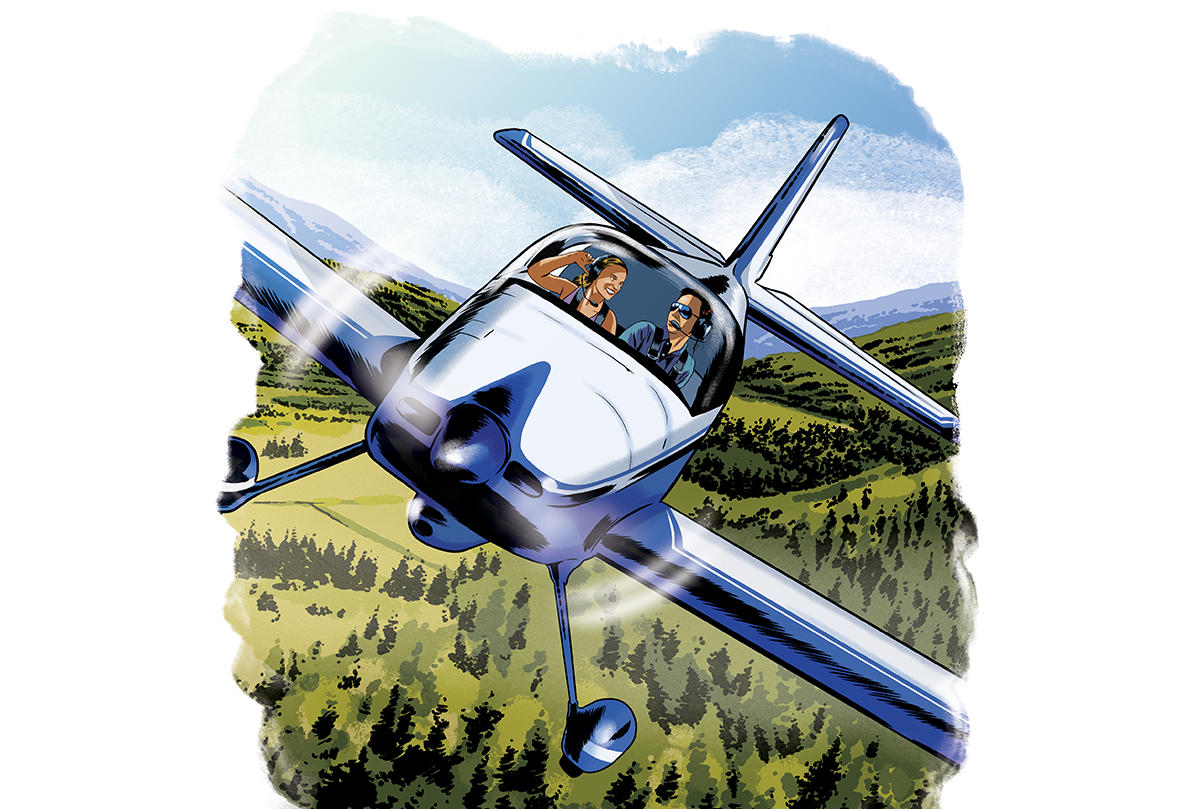Are We There Yet?
When you share you experiences and knowledge with your passengers they may catch the aviation bug.

It’s best to engage your passenger(s) in the piloting experience, according to the author. [Illustration: Joel Kimmel]
The question, “Are we there yet?” is asked so often by young children traveling with little concept of distance and time that it has become a joke for adults to ask it of each other when traveling as well. It’s not always a joke for adults. For pilots, it can be indicative of your passengers’ disconnect from the flying process, like children strapped into a plurality of seats with their sipper cups and board books for company.
Why do we fly people without explaining to them what we’re doing? Why do we shush inquisitiveness from adults and kids? Some of us make the effort to take passengers along through the walk around and explain what we’re looking for. Some passengers are delighted to learn this, and they should be kept involved in the entire flight, for they might end up in flight school. Others are bored by it and just want to get in and get somewhere: they should fly commercial. How many of us have significant others that fit the latter description? You have my condolences.
The Great Inquisition
A friend has a Van’s Aircraft RV-6 that he often travels in with his wife. When he bought an Aeronca 7AC Champ and he took her on a cross-country flight to a familiar destination, halfway through the flight she inquired, “Shouldn’t we be there by now?” It was no joke.
In the RV-6, she had been quite chatty sitting beside him with the panel before her, and she seemed to be involved in the flight. Stuck in the rear seat of the Aeronca with nothing to interact with but the back of his head, it became clear that she wasn’t the least bit involved in the flight, and it turns out she really hadn’t been that involved during the RV flight.
On the return flight, he had her sit in front and do most of the flying. He no longer shared flight plans with her—he discussed them with her, and let her decide what the best route would be. She caught the bug, took an online ground school, and hired a local CFI for the air work. Within a year, she’d passed the knowledge test, found a designated pilot examiner who could fit in the RV-6, and earned her private pilot certificate. Flying isn’t for everyone, but we won’t know if flying is for our “one” until we involve them.
"I've been accused of mansplaining how to perform slips on final and how to time magnetos."
When I carry passengers in rough conditions, I have to keep them fully engaged with navigating or flying the airplane, just to avoid motion sickness. In Flight of Passage, Rinker Buck memorialized his nausea in the back seat of the family Piper PA-11, begging his brother—while being slammed by Taconic turbulence—to let him fly so he could keep his breakfast down. We can learn from his experience.
Teaching Leads to Mastery
The best way to master a subject is to teach it. We’ll never possess all the answers, but we can learn humbly from the questions others ask. (If you’re a narcissist, fully aware of your incompetence, and can’t admit that you’re ignorant of or wrong about anything, go to a golf course instead of an airport.)
By sharing our experiences and imparting knowledge to our passengers, we exhibit our respect and caring for them. The airlines are required to conduct a passenger safety brief prior to every flight. How many of us do this in GA? The preflight brief is the minimum we should be teaching our passengers. If they appear disinterested, keep them involved anyway, at least until the aircraft is tied down or chocked at the destination.
There may be social obstacles to sharing our passion for flight with our passengers. I’ve been accused of mansplaining how to perform slips on final and how to time magnetos (it may have been my gesticulating with manly hands and my use of the expression, sparky-sparky that gave this impression).
Trying to connect with someone toting a cell phone is also a source of frustration. The “not my job” attitude can be exasperating, usually expressed with, “Why are you telling me this?” I typically respond with: “Because I’ll need your help.” Once their eyes stop rolling, I keep them busy with a finger on the chart and their eyes looking out, a vintage luxury that glass panels sorely lack.
A Wake-Up Call To Promote GA
Recent advances in avionics have minimized pilot workloads to the point where boredom can be more of a safety issue than the complacency that accompanies our overconfidence in the sparky-sparky system. Years ago, most GA autopilots performed altitude and heading duties only. There is no more helpless a feeling than hearing the faint voice of someone on the frequency who, while flying on top to the coast, succumbed along with his passengers to the soporific drone of well-synchronized props, awaking almost two hours out over the ocean with only 40 minutes of fuel remaining. For some, the greatest compliment a passenger can give a pilot is to fall asleep during the flight, but the best compliment is actually to stay involved with the flight.
The next time we hear—“Are we there yet?”—let it be a wake-up call that we could be doing more to promote GA by engaging our passengers more in our flying.
This article was first published in the 2022 Southeast Adventure Guide of FLYING Magazine.

Subscribe to Our Newsletter
Get the latest FLYING stories delivered directly to your inbox






